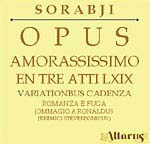Opus Amorassissimo, etc. is perhaps the least known yet most controversial of Kaikhosru Sorabji’s large-scale, unpublished and unperformed piano works. According to Altarus producer Robyn Birde, its recently discovered manuscript encompasses 6,969 oblong pages. Incredible as it may seem, Sorabji apparantly composed the entire work within a mere seven days during January of 1963, in direct response to Ronald Stevenson’s Passacaglia on D-S-C-H, premiered a few months earlier. Not to be outdone, Sorabji appropriated Stevenson’s motto theme and derived every possible motivic permutation he could from it. He then combined the results with themes derived from Shostakovich’s Leningrad Symphony, Busoni’s Doktor Faust, Verdi’s Anvil Chorus, Bach’s signature B-A-C-H theme, Havergal Brian’s opera The Tigers, Joseph Meek’s then-popular Telstar, and the inevitable (for Sorabji) Dies Irae.
Sorabji’s polytextural imagination runs at full tilt throughout the composition’s nine-hour span, and scarcely stops to breathe let alone consider an average audience’s ability to absorb a constant onslaught of intricate, harmonically dense ideas. Imagine the thickest slabs of Opus Clavicembalisticum superimposed on top of each other in different keys and different rhythms, and you’ll get the gist of OA’s sound world. Glancing at the score, you’d think it impossible for a single human being to play the notes, let alone voice them in accordance with Sorabji’s micro-managed specifications at tempos most mortals would consider unobtainable.
Then again, you haven’t reckoned with Hugh G. Rackshawn. Altarus gives no information about this pianist, apart from his tenure as (believe it or not) Liberace’s “last protégé”, and that he “served under many famous conductors” (presumably as a rehearsal pianist or a coach?). What counts is that Hugh G. Rackshawn’s technical apparatus, judging from his performance, is prodigious. In the variations, for example, pay attention to that thankless 15-minute sequence of 64th notes in alternating unison and mirror patterns. You won’t believe that two human hands could achieve climaxes of such unbearable intensity. Or consider Rackshwan’s long, sustained lines in the sextuple fugue’s penultimate stretto, and how they quiver against the daunting filagree.
The pianist’s rich tone is helped by his piano: a custom-built, one-of-a-kind, rhinestone-gilded Wurlitzer Imperial Grand. It’s obvious that the engineers bent over backward to ensure that this piano’s unique timbre was captured to such realistic effect as it is here. Given the work’s mammoth scope, one would have expected serious, penetrating program notes rather than an overlong and incomprehensible poem by the performer. And why doesn’t Altarus demarcate the music’s many sections with more than one track per disc? At least the elegant leather slipcase keeps all eight discs bound and secure for life. Let’s hope Altarus eventually will release its long-overdue premiere recording of Sorabji’s foreboding Tantrik Symphony for solo piano. [4/2/2004]
































